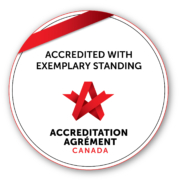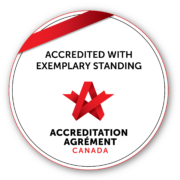BULLETIN – SAFETY BULLETIN
SAFETY CULTURE
Safety is one of our Accreditation Quality Dimension. It focuses on creating a culture of safety at Menno Place. Within the safety quality dimension there are 4 Required Organizational Practices (ROPs) that must be met to successfully complete Accreditation which will occur October 17-20, 2022.
How do we comply with the Safety ROPs?
Menno Place has dedicated resources to adopt and implement a variety of safety reporting measures including reporting events and disclosing them. Safety is embedded in Menno Place’s Strategic Plan. Leaders regularly report to the Quality Improvement Risk Management Committee (QIRM) on safety concerns and provide recommendations and progress reports on key initiatives in process. Additionally, leaders provide detailed review on all the quality indicators.
How will the ROPs be evaluated?
Surveyors will tour Menno Home & Menno Hospital and test compliance for each of the ROPs. Specifically they will gather information by:
- Talking and listening to team members, families, residents, volunteers, and community partners such as physicians, pharmacists, and contractors.
- Observations of what is taking place as they tour the sites
- Reviewing resident health records
Who needs to be aware of the Safety Culture ROPs?
Surveyors will meet with teams, physicians, staff, residents, families, students and volunteers so everyone should be aware of the Safety Quality Dimension and the associated ROPs and priority practices. If you are asked a question on an unfamiliar topic, please refer the surveyor to the appropriate individual or supervisor.
ROP 1 Accountability for Quality
Does the Menno Place Board have a demonstrated commitment to quality performance in the organization?
Yes, the Board of Menno Place demonstrates a clear commitment to quality by having it as a standing item on the agenda of its meetings.
Evidence: How do we do this?
- The Board is engaged in overseeing quality in order to ensure that quality performance continually improves. Governing bodies are accountable for the quality of care provided by their organizations. The Board is aware of key quality and safety principles in order to understand, monitor, and oversee the quality performance of the organization.
- The Board has a clear commitment to quality as evidenced by having it as a standing item at each meeting.
- The Leaders and Board review a number of indicators on a regular basis.
- Resident safety is embedded in the Menno Place strategic plan.
- Menno Place’s quality performance indicators are directly linked to strategic goals and objectives. Knowledge gained from the review of quality performance indicators (i.e. data collected on number of falls, pressure ulcers, restraints, sick time, injuries etc.) is used to set the agenda, inform strategic planning, and develop an integrated quality improvement plan. Resource allocation may be determined by priorities arising out of evaluation of quality performance.
- Menno Place has a Quality Improvement and Risk Management Committee (QIRM). This committee consists of Senior Leaders and Directors and Board members and meets quarterly. The QIRM committee reports to the Board.
ROP 2 Workplace Violence Prevention Program
Does Menno Place have a documented and coordinated approach to prevent workplace violence?
Yes, Menno Place does have a documented and coordinated approach to prevent workplace violence.
Evidence: How do we do this?
- We have written policies, available on SharePoint: Workplace Violence Prevention AP 3.41 and Workplace Harassment and/or Bullying AP 3.43
- Risk assessments are conducted to determine and identify the risk of workplace violence
- Staff are educated and trained on workplace violence prevention through Surge learning and hands on workshops.
- The JOHS committee regularly reviews policies, incidents, and conducts audits and assessments to prevent workplace violence.
ROP 3 Client Safety Incident Disclosure
Does Menno Place have a documented and coordinated approach for disclosing client safety incidents to residents and families?
Yes, Menno Place has a policy “Disclosure of Harm or Near Miss” AP 2.28, available on SharePoint.
Evidence: How do we do this?
- Disclosure is the process used by Menno Place to inform a resident and/or their family of a specific harmful incident. During this process the implications of that incident are discussed in a respectful, sensitive, and thorough manner. Part of the process involves support for residents and staff as well.
- Menno is committed to honest and open communication with residents and families when harm occurs. This may include a fall with injury, medication error, unexpected death, missing resident, theft, etc.
- A complete, accurate, and factual account of the disclosure discussion(s) is recorded in the resident’s health record.
- An example of support to resident’s, families, and team members includes emotional/psychological support by social worker, 3rd party counseling service such as the Employee Family Assistance Program, and/or spiritual care.
ROP 4 Resident Safety Incident Management System
Are there processes in place to review client safety incidents, recommend actions and monitor improvements?
Yes, Menno Place addresses client safety incidents and takes action to reduce any risk of recurrence.
Evidence: How do we do this?
- Menno Place encourages everyone to report and learn from resident safety incidents including harmful, no-harm and near miss. The reporting system is simple, clear, confidential, and focused on system improvement. Residents and families are also encouraged to report.
- We have written policies, available on SharePoint: Incident Reports RCS 1.09, Reportable Incidents RCS 1.14, and Safety of Residents RCS 2.01.
- We utilize resources from the Canadian Patient Safety Institute and learns from shared client safety incidents from other sources.
- Broadly communicating incident analysis internally and externally in order to build confidence in incident management and promote collective learning.
What are some of the questions surveyors may ask about Safety Culture?
During the onsite visit, surveyors will ask questions about Menno Place and how they comply with the ROPs and standards. A sample of questions may include the following:
- Do staff feel there is a no blame culture?
- Are there open discussions about resident safety issues in each neighborhood?
- What can you tell us about the incident reporting system at Menno Place?
- Can you tell me about an improvement initiatives that has occurred in your work area over the past year?
- Have you reported any near miss incident? Can you give an example?
- Can you define a harmful event?
Thank you for your part in making this Accreditation Survey another successful one!




